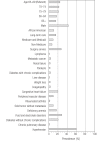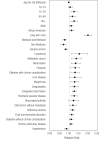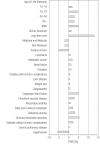Risk factors for 30-day hospital readmission in patients ≥65 years of age - PubMed (original) (raw)
Risk factors for 30-day hospital readmission in patients ≥65 years of age
Marc D Silverstein et al. Proc (Bayl Univ Med Cent). 2008 Oct.
Abstract
The objective of the study was to develop and validate predictors of 30-day hospital readmission using readily available administrative data and to compare prediction models that use alternate comorbidity classifications. A retrospective cohort study was designed; the models were developed in a two-thirds random sample and validated in the remaining one-third sample. The study cohort consisted of 29,292 adults aged 65 or older who were admitted from July 2002 to June 2004 to any of seven acute care hospitals in the Dallas-Fort Worth metropolitan area affiliated with the Baylor Health Care System. Demographic variables (age, sex, race), health system variables (insurance, discharge location, medical vs surgical service), comorbidity (classified by the Elixhauser classification or the High-Risk Diagnoses in the Elderly Scale), and geographic variables (distance from patient's residence to hospital and median income) were assessed by estimating relative risk and risk difference for 30-day readmission. Population-attributable risk was calculated. Results showed that age 75 or older, male sex, African American race, medical vs surgical service, Medicare with no other insurance, discharge to a skilled nursing facility, and specific comorbidities predicted 30-day readmission. Models with demographic, health system, and either comorbidity classification covariates performed similarly, with modest discrimination (C statistic, 0.65) and acceptable calibration (Hosmer-Lemeshow χ² = 6.08; P > 0.24). Models with demographic variables, health system variables, and number of comorbid conditions also performed adequately. Discharge to long-term care (relative risk, 1.94; 95% confidence interval, 1.80- 2.09) had the highest population-attributable risk of 30-day readmission (12.86%). A 25% threshold of predicted probability of 30-day readmission identified 4.1 % of patients ≥65 years old as priority patients for improved discharge planning. We conclude that elders with a high risk of 30-day hospital readmission can be identified early in their hospital course.
Figures
Figure 1
Prevalence of risk factors for 30-day hospital readmission. The prevalence of the significant demographic, health system, and Elixhauser comorbidity predictors of 30-day hospital readmission among the 29,292 eligible elders admitted to the seven BHCS hospitals from July 2002 to June 2004 is shown.
Figure 2
Relative risk of 30-day hospital readmission. The relative risk and 95% confidence intervals for the significant demographic, health system, and Elixhauser comorbidity predictors of 30-day hospital readmission among the 29,292 eligible elders admitted to the seven BHCS hospitals from July 2002 to June 2004 are shown.
Figure 3
Population-attributable risk (PAR) of 30-day hospital readmission. The population-attributable risk of the significant demographic, health system, and Elixhauser comorbidity predictors of 30-day hospital readmission among the 29,292 eligible elders admitted to the seven BHCS hospitals from July 2002 to June 2004 is shown. Among these elders, dual Medicare and Medicaid insurance, no Medicare insurance coverage, admission to a surgical service, or hypertension with complications as a comorbidity were associated with a significantly lower risk of 30-day hospital admission.
Similar articles
- Using Visual Analytic Methods to Identify Patient Groups [Internet].
Bhavnani SK, Kuo YF. Bhavnani SK, et al. Washington (DC): Patient-Centered Outcomes Research Institute (PCORI); 2021 Jun. Washington (DC): Patient-Centered Outcomes Research Institute (PCORI); 2021 Jun. PMID: 38781405 Free Books & Documents. Review. - Not All Discharge Settings Are Created Equal: Thirty-Day Readmission Risk after Elective Colorectal Surgery.
Hoang CM, Davids JS, Maykel JA, Flahive JM, Sturrock PR, Alavi K. Hoang CM, et al. Dis Colon Rectum. 2020 Sep;63(9):1302-1309. doi: 10.1097/DCR.0000000000001727. Dis Colon Rectum. 2020. PMID: 33216499 - A "Hospital-Day-1" Model to Predict the Risk of Discharge to a Skilled Nursing Facility.
Oseran AS, Lage DE, Jernigan MC, Metlay JP, Shah SJ. Oseran AS, et al. J Am Med Dir Assoc. 2019 Jun;20(6):689-695.e5. doi: 10.1016/j.jamda.2019.03.035. J Am Med Dir Assoc. 2019. PMID: 31133235 - A prediction model to identify patients at high risk for 30-day readmission after percutaneous coronary intervention.
Wasfy JH, Rosenfield K, Zelevinsky K, Sakhuja R, Lovett A, Spertus JA, Wimmer NJ, Mauri L, Normand SL, Yeh RW. Wasfy JH, et al. Circ Cardiovasc Qual Outcomes. 2013 Jul;6(4):429-35. doi: 10.1161/CIRCOUTCOMES.111.000093. Epub 2013 Jul 2. Circ Cardiovasc Qual Outcomes. 2013. PMID: 23819957 - Predicting the Risk of Readmission in Pneumonia. A Systematic Review of Model Performance.
Weinreich M, Nguyen OK, Wang D, Mayo H, Mortensen EM, Halm EA, Makam AN. Weinreich M, et al. Ann Am Thorac Soc. 2016 Sep;13(9):1607-14. doi: 10.1513/AnnalsATS.201602-135SR. Ann Am Thorac Soc. 2016. PMID: 27299853 Free PMC article. Review.
Cited by
- Analysis of Clinical Criteria for Discharge Among Patients Hospitalized for COVID-19: Development and Validation of a Risk Prediction Model.
Schnipper JL, Oreper S, Hubbard CC, Kurbegov D, Egloff SAA, Najafi N, Valdes G, Siddiqui Z, O 'Leary KJ, Horwitz LI, Lee T, Auerbach AD. Schnipper JL, et al. J Gen Intern Med. 2024 Nov;39(14):2649-2661. doi: 10.1007/s11606-024-08856-x. Epub 2024 Jun 27. J Gen Intern Med. 2024. PMID: 38937368 Free PMC article. - Fragmented Readmissions From a Nursing Facility in Medicare Beneficiaries.
Turbow SD, Perkins MM, Vaughan CP, Klemensen T, Culler SD, Rask KJ, Clevenger CK, Ali MK. Turbow SD, et al. J Appl Gerontol. 2024 Nov;43(11):1762-1771. doi: 10.1177/07334648241254282. Epub 2024 May 26. J Appl Gerontol. 2024. PMID: 38798097 Free PMC article. - Interpretable machine learning models for hospital readmission prediction: a two-step extracted regression tree approach.
Gao X, Alam S, Shi P, Dexter F, Kong N. Gao X, et al. BMC Med Inform Decis Mak. 2023 Jun 5;23(1):104. doi: 10.1186/s12911-023-02193-5. BMC Med Inform Decis Mak. 2023. PMID: 37277767 Free PMC article. - Intensive care unit readmission in adult Egyptian patients undergoing living donor liver transplant: A single-centre retrospective cohort study.
Salah M, Montasser IF, El Gendy HA, Korraa AA, Elewa GM, Dabbous H, Mahfouz HR, Abdelrahman M, Goda MH, Bahaa El-Din MM, El-Meteini M, Labib HA. Salah M, et al. World J Hepatol. 2022 Jun 27;14(6):1150-1161. doi: 10.4254/wjh.v14.i6.1150. World J Hepatol. 2022. PMID: 35978667 Free PMC article. - Interventions to Reduce Hospital Readmissions in Older African Americans: A Systematic Review of Studies Including African American Patients.
Bhandari S, Dawson AZ, Kobylarz Z, Walker RJ, Egede LE. Bhandari S, et al. J Racial Ethn Health Disparities. 2023 Aug;10(4):1962-1977. doi: 10.1007/s40615-022-01378-4. Epub 2022 Aug 1. J Racial Ethn Health Disparities. 2023. PMID: 35913544 Free PMC article. Review.
References
- DeFrances CJ, Hall MJ, Podgornik MN. Advance Data from Vital and Health Statistics, no 359. Hyattsville, MD: National Center for Health Statistics; 2005. 2003 National Hospital Discharge Survey.
- National Center for Health Statistics. Health, United States, 2005 with Chartbook on Trends in the Health of Americans Hyattsville, MD, 2005. - PubMed
- Anderson GF, Steinberg EP. Hospital readmissions in the Medicare population. N Engl J Med. 1984;311(21):1349–1353. - PubMed
- Anderson GF, Steinberg EP. Predicting hospital readmissions in the Medicare population. Inquiry. 1985;22(3):251–258. - PubMed
- Zook CJ, Moore FD. High-cost users of medical care. N Engl J Med. 1980;302(18):996–1002. - PubMed
LinkOut - more resources
Full Text Sources
Other Literature Sources


